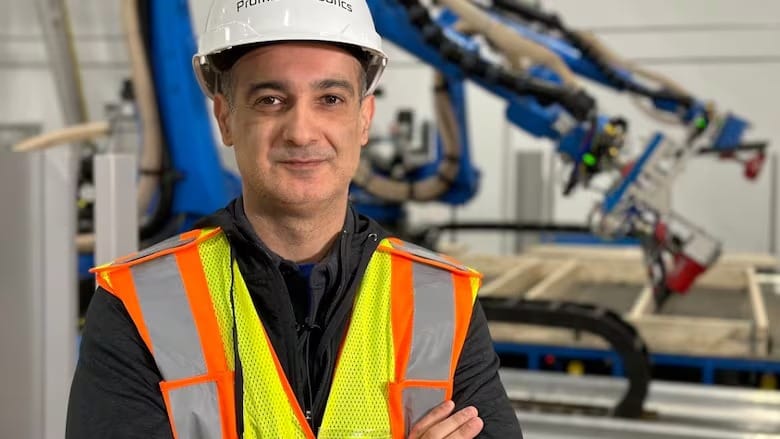AI and robotic arms flex new tech muscles to boost lagging home construction in Canada
Entrepreneurs adapting robotic arms to help contend with country's housing shortage

Ramtin Attar, CEO and co-founder of Promise Robotics, stands in a modest warehouse located in an industrial park near Edmonton's airport, observing robots that he believes could revolutionize the construction industry.
Promise Robotics is part of a small group of Canadian firms and researchers developing technologies aimed at helping homebuilders innovate at a pace similar to other sectors. In front of Attar are four robotic arms, similar to those used in automotive manufacturing, which are assembling the walls, floors, and roofs of houses.
Using artificial intelligence (AI), these robots analyze blueprints and autonomously make decisions on tasks such as which cuts to make, what to nail together, and where to drill holes for wiring and plumbing.
"They can decide on the fly what tools they need and what tasks they should perform," Attar said.
This concept is a significant shift for an industry experts say requires modernization to tackle the shortage of skilled labor and meet the growing demand for new housing in Canada, amid a housing affordability crisis.
"There is a large gap between the construction industry and other sectors that have already integrated AI and robotics," said Daeho Kim, an assistant professor of civil engineering at the University of Toronto who researches robotic construction.
Although there are new high-tech building materials and smart homes being constructed, much of the construction work still involves traditional manual labor. A recent report from McKinsey & Company highlighted that the $12-trillion global architecture, engineering, and construction sector has been "among the slowest to digitize and innovate."
Attar emphasized that Canada's construction industry has been slow to embrace new technologies, stressing the need for a significant boost in productivity to meet the federal and provincial government's homebuilding targets. These targets include the creation of 3.87 million new homes by 2031, a challenging goal complicated by housing policies, regulations, infrastructure costs, and a continued shortage of construction workers.
Attar believes technology, including robotics, can help reduce the time it takes to build houses, apartments, and condos.
Promise Robotics is developing AI to handle tasks that have traditionally been performed by humans. Instead of using single-function robots programmed for specific tasks, the company uses off-the-shelf robotic arms and programs its own AI to enable them to construct parts of houses.
Since its founding in 2019 and with a $25 million investment, Promise Robotics has developed an AI "brain" that can scan building plans and determine the fastest methods to construct parts of a house or multi-unit building. The robots can make various types of walls, floors, and roofs, offering flexibility compared to larger machines used in factories that produce prefabricated homes.
While Attar, a former Autodesk employee, brings his technical expertise, his co-founder, Reza Nasseri, has decades of experience in construction and founded one of Canada's largest pre-fabricated homebuilding companies, ACQBuilt.
Unlike ACQBuilt's multimillion-dollar factory, Promise Robotics' system is portable and can be set up in warehouse spaces at a fraction of the cost. This has attracted significant interest from homebuilders.
Once the walls, floors, and roof are constructed, they are sent to the building site, where workers use a crane to assemble the home, completing it in about a day. The company claims that it can reduce the total construction time of a home to five months, which is about half the typical duration according to government data.
Attar mentioned that the company already has a client in Edmonton, and over 20 other builders from across Canada visited Promise Robotics in 2024, drawn by the potential to set up temporary facilities with robotic arms near their construction sites, which could double their production capacity.
Kevin Lee, CEO of the Canadian Home Builders' Association, stated that most construction companies are too small to invest in developing their own technology, but "robotics, if they can be done in a cost-effective way, start to become very interesting."
While Promise Robotics focuses on AI-powered robots for factory settings, another company, Horizon Legacy, has developed a robotic arm capable of working on construction sites. Their Val 2.0 robotic arm acts as a portable 3D printer that pours special concrete mix to form walls of a house. Horizon Legacy's CEO, Nhung Nguyen, highlighted the labor shortages in Canada and said their technology helps address this by reducing the crew size while improving insulation.
Mounted on a trailer, the Val 2.0 arm is controlled by a human operator with a joystick, rather than AI. Nguyen said the aim is to attract young people back into construction by using technology to improve industry standards.
Both companies acknowledge that while robots will help address the construction labor shortage, there will still be roles for workers that require more dexterity than robots can provide, as well as opportunities for "upskilling" to manage or guide robotic devices.
In addition to robotic arms, advancements in construction technology include efforts to turn existing machinery like cranes and excavators into autonomous robots. At the University of British Columbia's Smart Structures Lab, civil engineering professor Tony Yang is working on equipping these machines with sensors and connecting them to computers via wireless signals. On-site tests have already been conducted with Bird Construction in Richmond, B.C., where cranes and forklifts are guided by AI instead of remote control operators.
Yang likened this technology to self-driving cars, predicting that within the next decade, autonomous construction machines will become more common on construction sites.
However, Lee of the Canadian Home Builders' Association stressed that policy and regulatory changes are essential to speed up the housing construction process.
Back in Edmonton, Attar hopes Canadian companies can lead a transformation in the construction industry that not only benefits Canada but also has global potential.





